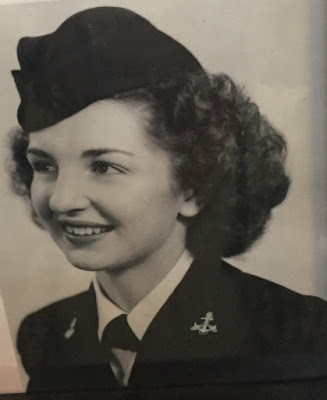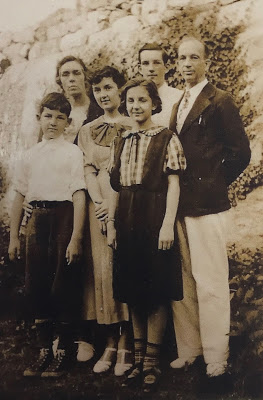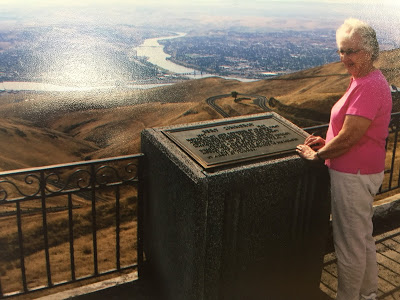By Liv Stecker

Marianna “Jean” Mix didn’t much care for school. It wasn’t that she didn’t have the smarts for it – she just felt like she had better things to do. The daughter of a horseback minister, Jean had two brothers and a sister growing up in the depression era northeastern United States. After she graduated high school in Stamford Connecticut in 1942 she tried college for a year before she moved on to a job with Machlett Laboratories where she tested medical equipment for military hospitals. As World War II drew Jean’s peers into service across the globe, her mother encouraged her to sign up to serve in one of the newly formed women’s divisions in the military. In the fall of 1944, Jean tested for WAVES, Women Accepted for Emergency Volunteer Services, a branch of the United States Navy. Distinct from other women’s corps, WAVES was a specialized Naval group of enlisted service members, rather than auxiliary.
WAVES actively recruited women with college degrees, training and experience in science and technological fields. They were tested and screened rigorously, requiring background checks and solid references. Jean was one of the few selected to enter the training program. Growing up, Jean had considered entering the field of nursing as a profession but was concerned that because she had flat feet that she wouldn’t be able to endure the long hours. But taking care of people was still something that drew her, so she opted to go into training for the hospital corps with WAVES.
The Hospital Corps were established by the Naval Department in 1898 to answer the demand for medical attendants in the Navy. Hospital corpsman were trained in medical terminology, anatomy and physiology, record keeping, administering medication and shots, assessing vital signs such as temperature and pulse, wound dressing, “therapeutic back rubs”, and Artificial Respiration and Resuscitation, the predecessor to modern CPR for drowning victims which was at the time performed with the patient lying on his stomach.

Passing in the top 10% of her class, Jean was given her pick of assignments. As female service members in the Navy were not allowed to serve overseas or on ships, Jean opted for the Great Lakes Naval Training Station outside of Chicago. She laughs about her learning experience, “Maybe it wasn’t so much that I was smart, maybe everybody else made me look good!” The twinkle in Jean’s eye lends a clue to the energetic curiosity that is as alive and well a few days after her 93rd birthday as it was 73 years ago when she graduated WAVES and went to work at the hospital. Jean was promoted to Hospital Apprentice 1st Class and began her work at the hospital. She says that more than anything she remembers giving shots to the injured sailors. “One poor guy got so many shots that his backside looked like a pincushion!” She chuckled. Vaccination and antibiotic shots were administered routinely to patients in the gluteal muscles, and was one of the primary duties of the hospital corps members. In good fun, recovering patients at the Great Lakes Naval Station were given certificates of membership in the “Order of the Perforated Rectum.”
Jean’s first assignment at the Naval Station was in the eye surgery ward, where she remembers vividly being allowed to assist in the eye removal surgery for an injured pilot named Ray, who also became her first “boyfriend.” While her normal duties included administering eye drops and changing dressings, assisting in surgery was usually reserved for the nurses on staff. Injured eyes were replaced with steels balls, and Jean remembers groups of recovering soldiers being sent to Chicago to be fitted for false eyes that slid in over the steel balls.
When she left the eye ward she was reassigned to the rheumatic fever ward where she worked to keep restless patients comfortable during the painful illness. In this ward, Jean recalls that the patients were stacked in bunks, and remembers standing on a chair one night to give a suffering sailor a dose of APC (aspirin, phenacetin and caffeine) and rubbing his back until he fell asleep.
In June of 1945, Jean was reassigned to the chest surgery ward, where wounded Marines were recovering from massive chest injuries and subsequent surgeries. “Practically everyone on the ward had a big hole is his back either with drainage and irrigations tubes or great gobs of packing in it.” Jean recalled in an interview with her granddaughter in 2002. It was here that she met Minard “Tommy” Thompson, a marine who had been in Peleliu in the New Guinea Islands when he was injured by two grenades in the fall of 1944. Tommy was in the last stages of a 13 month rehabilitation that involved major skin grafts and serious complications from his wounds, but by the time he met Jean he was recovering and was assigned to the cleaning detail in the chest surgery ward. Jean and Tommy went on daily walks around the hospital, and eventually Jean took him off hospital grounds and rented a tandem bicycle that they took out for rides.
In August of 1945, the United States dropped an atomic bomb on Hiroshima, Japan triggering the surrender of the empire that had dug their heels stoutly into the struggle in the Pacific. In a letter to her parents, Jean mentions the bomb that was called “Little Boy” by the allies when the Enola Gay dropped it over Japan. “…Just think what could happen when it gets into the wrong hands, which it is bound to. It could just wipe all life off the earth.” She writes.
Jean says that taking care of the injured soldiers and sailors and helping alleviate their suffering was the best part of her experience in WAVES. “I am glad I did it, and I am glad I didn’t have to stay any longer than I did.” In her short year with WAVES, Jean experienced the best and the worst that the Navy had to offer during World War II. In the fall of 1945, Tommy proposed to Jean and she accepted. She was given only five days leave for their wedding, but shortly after, she was released from duty as she was married to a disabled veteran.
Jean and Tommy settled in Iowa near Tommy’s hometown, and they had two children. Tommy went back to contracting, his job before he joined the marines, and Jean stayed at home to raise the children for a few years. “Don’t call me a housewife,” she smiles, “housewife sounds horrible. Mother is just fine.” She got a job with the postal service in Jesup, Iowa, where her son jokes that she started the Women’s Liberation movement. Jean saved up her money and invested in an apartment complex, and then another, becoming and entrepreneur after her own fashion as the years went on.

Jean Thompson was an avid swimmer, teaching swimming lessons, participating in synchronized swimming teams and long distance swims and scuba diving, as well as being an accomplished horseback rider.
“I liked to dabble in a lot of things,”she says about her various hobbies, but her first priority was her kids. She and Tommy divorced after 25 years but Jean says that no matter what, “I had to have my kids and I had to be with them,” making choices that enabled her to be with her son and daughter throughout their growing up years.
In 2011, Jean moved to Lewiston, Idaho to be closer to family. Her grandson Shannon drove with her from Iowa on a road trip that she considers one of the highlights of her life, stopping in Missoula to enjoy the local beer.
“For the education of my grandchildren, I will try anything!” She laughs. In 2011 as an 88 year old she tested for and earned her driver’s license in Idaho, and even a year later she was still swimming a mile at a time.
In 2015 she relocated again to the Colville area where her son and daughter in law lived. She moved into Parkview Assisted Living where she keeps her friends and family entertained with her spirit of adventure and keen sense of humor. Jean is a sparkling representation of the spirit of her generation and the wit and tenacity that made them so great.

